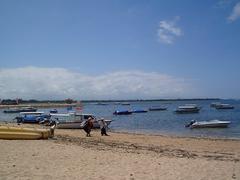Visiting Tanah Lot: Hours, Tickets, and Historical Sites in Denpasar, Indonesia
Date: 16/07/2024
Introduction
Tanah Lot, located in Denpasar, Indonesia, is one of Bali’s most iconic and culturally significant landmarks. This sea temple, perched on a rocky outcrop just off Bali’s southwestern coast, offers a unique blend of natural beauty, spiritual significance, and rich cultural experiences. Established in the 16th century by the revered Hindu priest Dang Hyang Nirartha, Tanah Lot translates to ‘Land in the Sea,’ aptly describing its distinctive position. The temple is dedicated to the sea gods and holds immense cultural and religious importance for the Balinese people (Bali.com). As one of the seven sea temples that form a spiritual protective barrier along Bali’s coast, Tanah Lot attracts millions of visitors annually, drawn by its breathtaking scenery, historical significance, and vibrant cultural events (Indonesia Travel). This guide aims to provide a comprehensive overview of Tanah Lot’s history, architectural evolution, visitor information including ticket prices and visiting hours, travel tips, and nearby attractions to help you make the most of your visit.
Table of Contents
- Introduction
- History of Tanah Lot
- Visitor Information
- Nearby Attractions
- Influence on Balinese Culture
- Economic Impact
- Challenges and Future Prospects
- FAQ Section
- Conclusion
History of Tanah Lot
Origins and Early History
Tanah Lot’s history dates back to the 16th century. The temple’s name, “Tanah Lot,” translates to “Land in the Sea,” aptly describing its unique position on a rock formation just off the shore. According to local legend, the temple was established by Dang Hyang Nirartha, a revered Hindu priest from Java. During his travels along the south coast of Bali, Nirartha was captivated by the beauty of the area and decided to rest on the rock. He felt a spiritual connection to the site and instructed local fishermen to build a shrine there to honor the sea god, Dewa Baruna (Bali.com).
Cultural and Religious Significance
Tanah Lot holds immense cultural and religious significance for the Balinese people. It is one of the seven sea temples that form a chain along the southwestern coast of Bali, each within sight of the next, creating a spiritual protective barrier for the island. The temple is dedicated to the sea gods and is an important site for pilgrimage. Balinese Hindus visit Tanah Lot to pray for prosperity, safety, and protection from evil spirits. The temple’s location, surrounded by the ocean, symbolizes the balance between the forces of nature and the spiritual world (Indonesia Travel).
Architectural Evolution
The architecture of Tanah Lot has evolved over the centuries, reflecting the island’s rich cultural heritage. The temple complex includes several shrines and pavilions, each with distinct architectural features. The main shrine, perched on the rock, is accessible only during low tide. The temple’s design incorporates traditional Balinese architectural elements, such as tiered roofs (meru) and intricate stone carvings. The use of natural materials, like coral and volcanic rock, enhances the temple’s harmony with its surroundings (Bali Tourism Board).
Historical Events and Preservation Efforts
Throughout its history, Tanah Lot has faced numerous challenges, including natural erosion and human impact. In the 1980s, the temple’s rock base began to deteriorate due to constant exposure to the ocean’s waves. Recognizing the cultural importance of Tanah Lot, the Indonesian government, with assistance from the Japanese government, initiated a major restoration project in the 1990s. The project involved reinforcing the rock base with artificial structures and restoring the temple’s original features. Today, approximately one-third of the rock is artificial, but the restoration has successfully preserved the temple’s historical and cultural integrity (UNESCO).
Modern-Day Relevance
In contemporary times, Tanah Lot continues to be a vital cultural and religious site, attracting millions of visitors annually. The temple is a focal point for various religious ceremonies and festivals, such as the Melasti ceremony, which involves a procession to the sea to purify sacred objects and offerings. The temple’s picturesque setting, with the backdrop of the Indian Ocean, makes it a popular destination for tourists seeking to experience Bali’s spiritual heritage and natural beauty (Bali Government Tourism Office).
Visitor Information
Visiting Hours and Ticket Prices
Tanah Lot is open daily from 7:00 AM to 7:00 PM. The best time to visit is during low tide when you can walk across the causeway to the temple. Ticket prices are approximately IDR 60,000 for adults and IDR 30,000 for children. It’s advisable to check the official website for the latest information on visiting hours and ticket prices.
Travel Tips
- Best Time to Visit: The temple is most beautiful at sunset, offering stunning views and photographic opportunities.
- What to Wear: Modest clothing is recommended as this is a religious site. Sarongs are available for rent at the entrance.
- Guided Tours: Consider hiring a local guide to learn more about the temple’s history and significance.
- Accessibility: The temple may not be easily accessible for those with mobility issues due to uneven terrain and steps.
Nearby Attractions
Batu Bolong Temple
Another sea temple located nearby, known for its unique arch-shaped rock formation.
Nirwana Bali Golf Club
An award-winning golf course offering spectacular views of the Indian Ocean and Tanah Lot.
Kedungu Beach
A serene beach ideal for surfing and relaxation, located just a short drive from Tanah Lot.
Influence on Balinese Culture
Tanah Lot’s influence extends beyond its religious significance, impacting various aspects of Balinese culture. The temple is a source of inspiration for local art, music, and dance. Traditional Balinese paintings often depict scenes of Tanah Lot, capturing its mystical ambiance and spiritual essence. The temple’s presence has also contributed to the development of local crafts, such as wood carving and stone masonry, as artisans create replicas and souvenirs for visitors (Bali Arts and Culture).
Economic Impact
The economic impact of Tanah Lot on the local community is substantial. The temple’s popularity as a tourist destination has spurred the growth of various businesses, including hotels, restaurants, and souvenir shops. The entrance fees and donations collected from visitors contribute to the maintenance and preservation of the temple. Additionally, the influx of tourists provides employment opportunities for local residents, supporting the region’s economy (Bali Economic Development).
Challenges and Future Prospects
Despite its enduring significance, Tanah Lot faces ongoing challenges, such as environmental threats and the pressures of mass tourism. Coastal erosion and rising sea levels pose risks to the temple’s structural integrity. Efforts to mitigate these threats include continuous monitoring and maintenance, as well as sustainable tourism practices to minimize environmental impact. The future of Tanah Lot depends on balancing the preservation of its cultural heritage with the demands of modern tourism (World Monuments Fund).
FAQ Section
Q: What are the visiting hours for Tanah Lot?
A: Tanah Lot is open daily from 7:00 AM to 7:00 PM.
Q: How much are the tickets for Tanah Lot?
A: Ticket prices are approximately IDR 60,000 for adults and IDR 30,000 for children.
Q: What is the best time to visit Tanah Lot?
A: The best time to visit is during low tide and at sunset for stunning views.
Q: Are there guided tours available?
A: Yes, guided tours are available and recommended to learn more about the temple’s history.
Q: Is Tanah Lot accessible for people with mobility issues?
A: The temple may be challenging to access due to uneven terrain and steps.
Conclusion
Tanah Lot stands as a testament to Bali’s rich cultural and spiritual heritage. From its establishment in the 16th century by Dang Hyang Nirartha to its ongoing significance in contemporary Balinese society, Tanah Lot remains a symbol of spiritual devotion and cultural identity (UNESCO). The temple’s picturesque setting, surrounded by the ocean, offers stunning views, especially at sunset, making it a popular destination for both spiritual seekers and tourists alike. Despite facing challenges such as coastal erosion and the pressures of mass tourism, ongoing preservation efforts and sustainable tourism practices ensure that Tanah Lot continues to inspire and captivate future generations (World Monuments Fund). Whether you are interested in history, culture, or simply looking for a serene place to relax, Tanah Lot offers a memorable and enriching experience. Plan your visit today to experience the magic and mystique of this iconic Balinese landmark.
References
- Bali.com. Discover the Rich History and Visitor’s Guide to Tanah Lot, Bali. Retrieved from Bali.com
- Indonesia Travel. Cultural and Religious Significance of Tanah Lot. Retrieved from Indonesia Travel
- UNESCO. Historical Events and Preservation Efforts at Tanah Lot. Retrieved from UNESCO
- World Monuments Fund. Challenges and Future Prospects of Tanah Lot. Retrieved from World Monuments Fund




